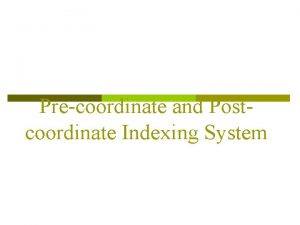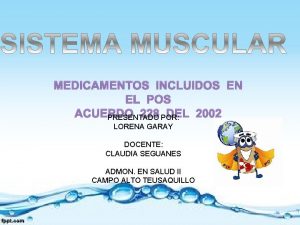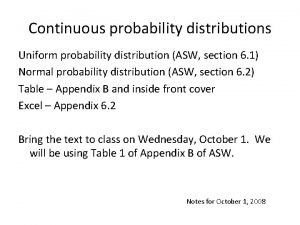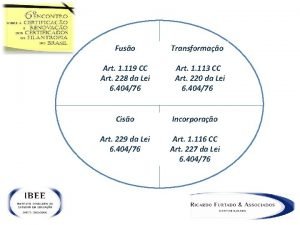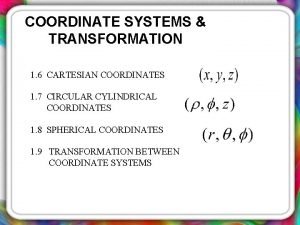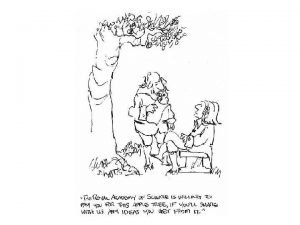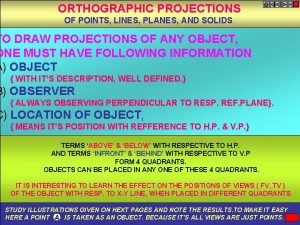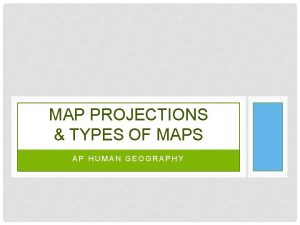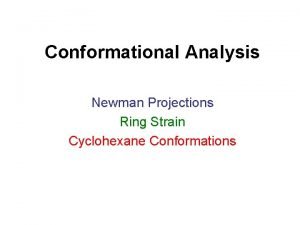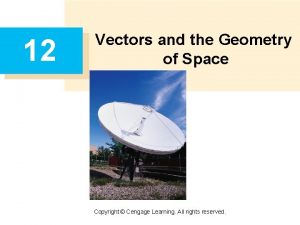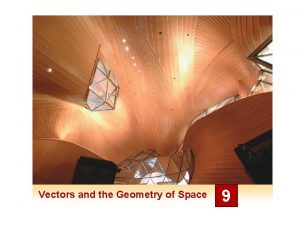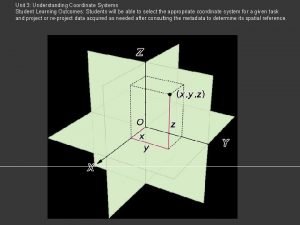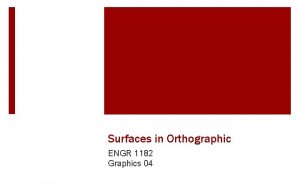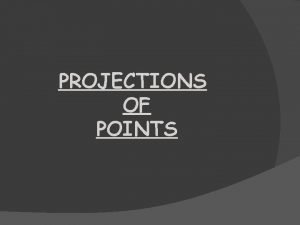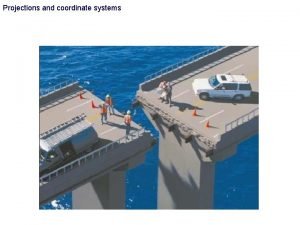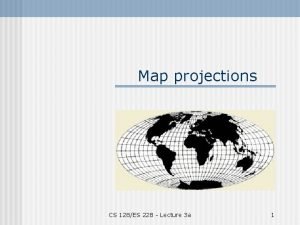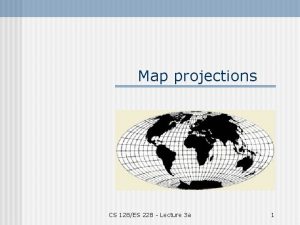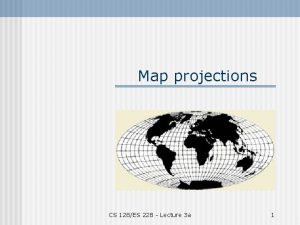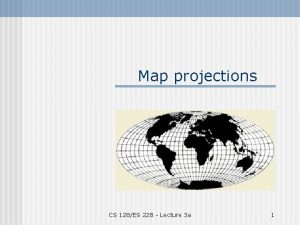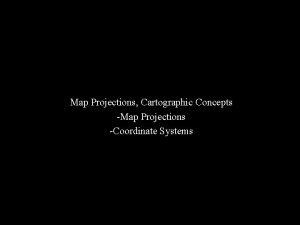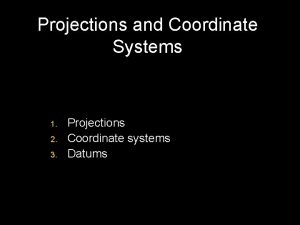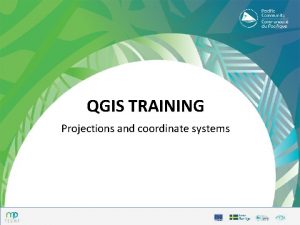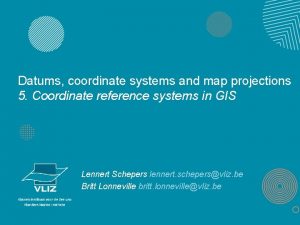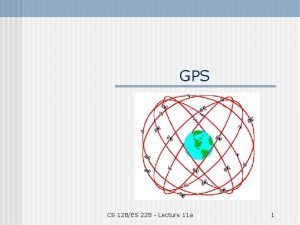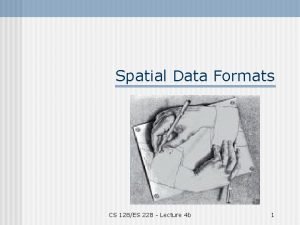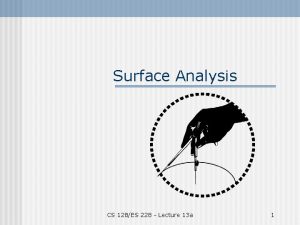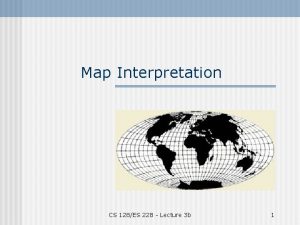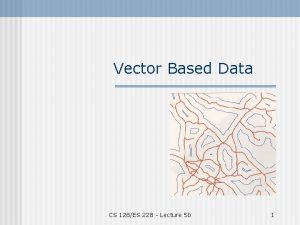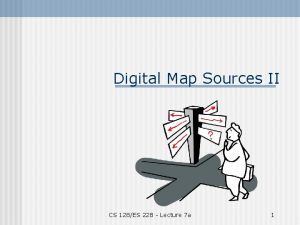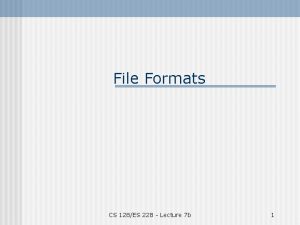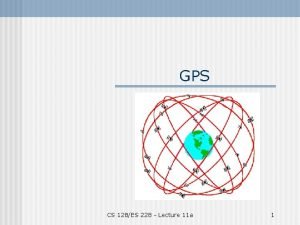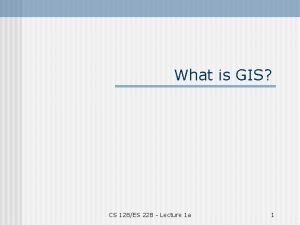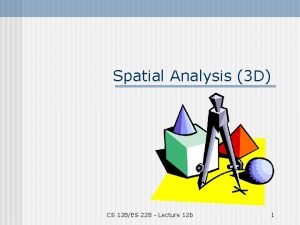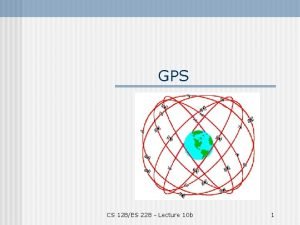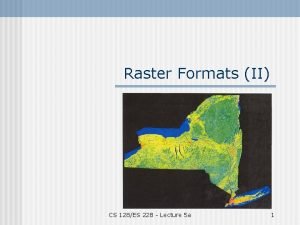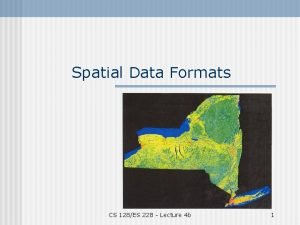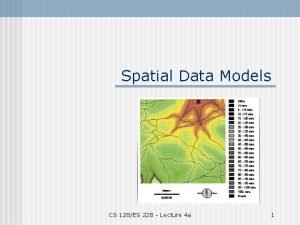Coordinate systems projections CS 128ES 228 Lecture 2




























- Slides: 28

Coordinate systems & projections CS 128/ES 228 - Lecture 2 b 1

Overview of the cartographic process 1. Model surface of Earth mathematically 2. Create a geographical datum 3. Project curved surface onto a flat plane 4. Assign a coordinate reference system CS 128/ES 228 - Lecture 2 b 2

1. Modeling Earth’s surface n Ellipsoid: theoretical model of surface - not perfect sphere - used for horizontal measurements n Geoid: incorporates effects of gravity - departs from ellipsoid because of different rock densities in mantle - used for vertical measurements CS 128/ES 228 - Lecture 2 b 3

Ellipsoids: flattened spheres n Degree of flattening given by f = (a-b)/a (but often listed as 1/f) n Ellipsoid can be local or global CS 128/ES 228 - Lecture 2 b 4

Examples of ellipsoids Local Ellipsoids Inverse flattening (1/f) Airy 1830 299. 3249646 Australian National 298. 25 Clarke 1866 294. 9786982 Clarke 1880 293. 465 Everest 1956 300. 8017 Global Ellipsoids International 1924 297 GRS 80 (Geodetic Ref. Sys. ) 298. 257222101 WGS 84 (World Geodetic Sys. ) 298. 257223563 CS 128/ES 228 - Lecture 2 b 5

Geodids: vertical reference surfaces n Like MSL (mean sea level) extended across continents n Based on network of precise gravity measurements n Can depart from ellipsoid by as much as 60 m CS 128/ES 228 - Lecture 2 b 6

2. Then what’s a datum? n Datum: a set of reference measurements for a particular region, based on specified ellipsoid + geodetic control points n > 100 world wide Some of the datums stored in Garmin 76 GPS receiver CS 128/ES 228 - Lecture 2 b 7

North American datums Datums commonly used in the U. S. : - NAD 27: based on Clarke 1866 ellipsoid centered on Meads Ranch, KS - NAD 83: based on GRS 80 ellipsoid centered on center of mass of the Earth CS 128/ES 228 - Lecture 2 b 8

Datum Smatum n NAD 27 or 83 – who cares? n One of 2 most common sources of mis-registration in GIS n (The other is getting the UTM zone wrong – more on that later) CS 128/ES 228 - Lecture 2 b 9

3. Map projections A reminder: the Earth is not flat! Producing a perfect map projection is like peeling an orange and flattening the peel without distorting a map drawn on its surface. CS 128/ES 228 - Lecture 2 b 10

Properties of a map projection n Area n Distance n Shape n Direction Projections that conserve area are called equivalent Projections that conserve shape are called conformal CS 128/ES 228 - Lecture 2 b 11

Two rules: Rule #1: No projection can preserve all four properties. Improving one often makes another worse. Rule #2: Data sets used in a GIS must be in the same projection. GIS software contains routines for changing projections. CS 128/ES 228 - Lecture 2 b 12

Geographical coordinates Latitude & Longitude § Both measured as angles from center of Earth § Reference planes: - Equator for latitude - Prime meridian for longitude CS 128/ES 228 - Lecture 2 b 13

Parallels and Meridians Parallels: lines of latitude. Meridians: lines of longitude. § Everywhere parallel § Converge toward the poles § 1 o always ~ 111 km (69 miles) § Some variation due to ellipsoid (110. 6 at equator, 111. 7 at pole) § 1 o =111. 3 km at 1 o = 78. 5 “ at 45 o = “ at 90 o CS 128/ES 228 - Lecture 2 b 0 14

Classes of projections a. Cylindrical b. Conical c. Planar (a. k. a. azimuthal) CS 128/ES 228 - Lecture 2 b 15

Cylindrical projections n Meridians & parallels intersect at 90 o n Often conformal n Least distortion along line of contact (typically equator) n Ex. Mercator CS 128/ES 228 - Lecture 2 b 16

Conical projections n Most accurate along “standard parallel” n Meridians radiate out from vertex (often a pole) n Ex. Albers Equal Area CS 128/ES 228 - Lecture 2 b 17

Planar projections n A. k. a Azimuthal n Best for polar regions CS 128/ES 228 - Lecture 2 b 18

Complications: aspect CS 128/ES 228 - Lecture 2 b 19

Complications: viewpoint CS 128/ES 228 - Lecture 2 b 20

Compromise projections CS 128/ES 228 - Lecture 2 b 21

Buckminster Fuller’s “Dymaxion” CS 128/ES 228 - Lecture 2 b 22

4. Coordinate systems (grids) Once a projection is chosen, the map needs a coordinate grid to measure location. Common systems: § State Plane Coordinates § UTM CS 128/ES 228 - Lecture 2 b 23

State Plane Coordinate System § Older system – usually based on Clarke 1866 ellipsoid and NAD 27 datum § Goal: distortion < 1 part in 10, 000 § Each state divided into either E-W or N-S zones, depending on its orientation. Most use either Transverse Mercator or Lambert Conformal projections (Alaska, New York, and Florida use both) § Only exception: Alaska panhandle (uses Oblique Transverse Mercator) CS 128/ES 228 - Lecture 2 b 24

State Plane Coordinate Zones CS 128/ES 228 - Lecture 2 b 25

Universal Transverse Mercator system § Based on a cylindrical projection running from pole-pole § Distortion minimized in a N – S “strip” (zone) § Zones are 8 o wide but overlap by 1 o on each side. 60 world wide. CS 128/ES 228 - Lecture 2 b 26

UTM coordinates § Coordinates are based on an arbitrary origin at equator and 500, 000 m west of central meridian § E-W position: “easting” N-S position: “northing” § NYS has 3 zones – most state-wide datasets use zone 18 CS 128/ES 228 - Lecture 2 b 27

Miscellaneous Coordinate Systems n Military grids n Land survey grids n Cadastral records n Other … CS 128/ES 228 - Lecture 2 b 28
 Post coordinate indexing example
Post coordinate indexing example Coordinate bond in co
Coordinate bond in co Acuerdo 228 medicamentos pos
Acuerdo 228 medicamentos pos Cs 228
Cs 228 Asw 228
Asw 228 Eaf 228
Eaf 228 1629-1695
1629-1695 Hymn 228
Hymn 228 Art 228 cc
Art 228 cc 01:640:244 lecture notes - lecture 15: plat, idah, farad
01:640:244 lecture notes - lecture 15: plat, idah, farad Differential surface area in cylindrical coordinates
Differential surface area in cylindrical coordinates Rotating coordinate systems
Rotating coordinate systems Operating system lecture notes
Operating system lecture notes Lecture sound systems
Lecture sound systems Lecture sound systems
Lecture sound systems Scalar vs vector projection
Scalar vs vector projection In orthographic projection the xy is known as
In orthographic projection the xy is known as A line pq 100 mm long
A line pq 100 mm long Projection quest
Projection quest Map types ap human geography
Map types ap human geography Multiview to isometric
Multiview to isometric Newman projections
Newman projections Cardio thoracic ratio
Cardio thoracic ratio Dot
Dot Dot product
Dot product Usgs map projections poster
Usgs map projections poster Thread like projections that are similar to tails
Thread like projections that are similar to tails What's missing
What's missing A point 30mm above xy line is the plan view
A point 30mm above xy line is the plan view
